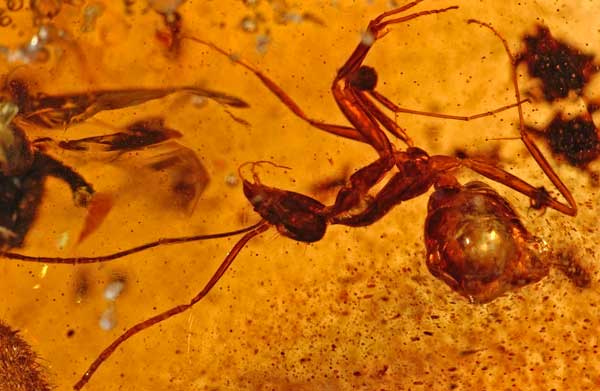
Insects in Ancient Amber Reveal Unexpected India-Asia Ties

A cache of ancient insects trapped in amber reveals that the Indian subcontinent wasn't as isolated 50 million years ago as previously believed, according to a new study.
The find, 330 pounds (150 kilograms) of fossilized tree resin excavated from northern India, contains more than 700 preserved insects and spiders, as well as plant spores, leaf portions and small flowers. Geological evidence shows that the landmass had been drifting independently for about 100 million years at the time, but the organisms in the amber are closely related to other species found in northern Europe, Australia, New Guinea and tropical America, the researchers report online this week in the journal Proceedings of the National Academy of Sciences.
That means the fauna of India didn't evolve in isolation, said study researcher David Grimaldi, the curator in the Division of Invertebrate Zoology at the American Museum of Natural History in New York.
"There must have been some connections between India and Asia that geologists aren't accounting for," Grimaldi told LiveScience.
Stepping stones
The resin is found in India's Gujarat province, where open-pit mining brings it to the surface. For the past three years, researchers have been visiting the mines for 10 days per year to collect the fossil-rich amber, study coauthor Jes Rust, professor of invertebrate paleontology at the Universität Bonn in Germany, told LiveScience.
Rust, Grimaldi and their colleagues then return the amber to the lab, where they painstakingly seek out the tiny insects, spiders and other arthropods inside. The preservation of the arthropods is particularly good in this amber, Rust said, meaning the researchers can dissolve the resin and extract whole preserved insects for study.
Sign up for the Live Science daily newsletter now
Get the world’s most fascinating discoveries delivered straight to your inbox.
"This is really unusual," Rust said. "It's like if you would have a complete dinosaur."
What is now the Indian subcontinent broke away from Africa about 150 million years ago and didn't join up with another landmass — Asia — until about 50 million years ago. So the research team expected to find a host of unique species that had evolved over those 100 million years. Instead, they learned that the insects and spiders in the amber are related to other species found fossilized everywhere from the Dominican Republic to the Baltic.
That could mean that Asia and India collided a few million years earlier than geological evidence suggests, Grimaldi said. Or it could support the theory that there were small islands connecting the continents, allowing species to "hop" across.
"Even though India might not have slammed into Asia at that time, there might have been stepping stones," Grimaldi said.
Ancient forests
Also hidden in the amber were clues to the ecosystem in India 50 million years ago. The Gujarat amber is the oldest evidence of a modern-type tropical rainforest in Asia, Grimaldi said. Plant fragments both in the amber and fossilized nearby paint a picture of an ancient landscape that would have looked much like the forests of Borneo today. The resin itself comes from a family of trees called Dipterocarpaceae, which dominate modern tropical forests in southeast Asia.
"The evidence is beginning to accumulate that tropical forests are ancient," Grimaldi said. "They probably go back to right after the K-T boundary," between the Cretaceous and Tertiary periods 65 million years ago, when non-avian dinosaurs went extinct.
The team plans to return to Gujarat in January to collect more samples, and the work in the lab is only beginning, the researchers said.
"We're still discovering all sorts of cool stuff in this amber," Grimaldi said. "Every day."
- Album: Ancient Life Trapped in Amber
- The Top 10 New Species
- 10 Things You Didn't Know About Animals

Stephanie Pappas is a contributing writer for Live Science, covering topics ranging from geoscience to archaeology to the human brain and behavior. She was previously a senior writer for Live Science but is now a freelancer based in Denver, Colorado, and regularly contributes to Scientific American and The Monitor, the monthly magazine of the American Psychological Association. Stephanie received a bachelor's degree in psychology from the University of South Carolina and a graduate certificate in science communication from the University of California, Santa Cruz.









